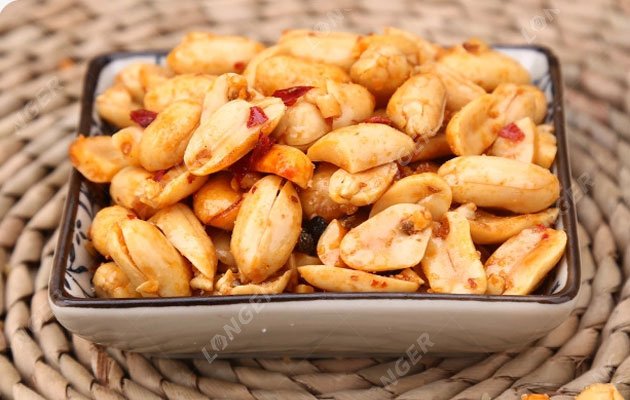What is the Process of Spicy Peanut Processing?
Introduction:
Spicy peanuts have gained immense popularity worldwide due to their unique and addictive flavors. Behind each fiery and savory bite lies an intricate process of peanut processing in factories. In this article, we delve into the steps involved in the production of spicy peanuts, exploring the journey from frying to packaging.
Spicy peanuts have gained immense popularity worldwide due to their unique and addictive flavors. Behind each fiery and savory bite lies an intricate process of peanut processing in factories. In this article, we delve into the steps involved in the production of spicy peanuts, exploring the journey from frying to packaging.

1. Frying:
The process of spicy peanut production begins with carefully selected raw peanuts. These peanuts are first thoroughly cleaned and sorted to remove impurities. Once cleaned, they are conveyed to large fryers filled with hot oil. The peanuts are carefully fried at controlled temperatures, ensuring a consistent and even cooking. Frying helps enhance the nutty flavors and adds a crispy texture to the peanuts.
2. Deoiling:
After frying, the peanuts undergo a deoiling process. Deoiling removes excess oil from the peanuts, ensuring a healthier and less greasy final product. The peanuts are placed on vibrating screens or deoiler machine to allow the oil to drain off. This step helps maintain the balance of flavors while reducing the oil content.
3. Cooling:
Following deoiling, the peanuts are cooled down to room temperature. This step is crucial to halt the cooking process and prevent further browning or overcooking. Air cooling or water cooling methods are commonly employed to lower the peanut temperature. Cooling also prepares the peanuts for the subsequent seasoning process.
4. Seasoning:
One of the defining characteristics of spicy peanuts is the vibrant and intense flavor imparted by the seasoning. Once cooled, the peanuts are transferred to seasoning drums or tumblers. Here, a precisely formulated blend of spices, herbs, chili powders, and other seasonings is added. The drum rotates, allowing the seasoning to coat each peanut evenly. This process is carefully controlled to ensure a consistent flavor profile throughout the batch.
5. Packaging:
After the peanuts have absorbed the desired flavors, they are ready for packaging. Specialized machinery is used to weigh and fill the spicy peanuts into bags, pouches, or containers. Packaging materials, such as aluminum-coated film, are employed to preserve the freshness, quality, and taste of the product. Proper sealing techniques are employed to ensure an airtight package that extends the shelf life of the spicy peanuts.
6. Quality Control:
Throughout the entire production process, stringent quality control measures are in place to maintain high standards. Quality checks are performed at various stages, including raw material inspection, frying, deoiling, seasoning, and packaging. These checks encompass factors such as taste, texture, aroma, and overall product quality. Any deviations from the set standards are identified and rectified to ensure consistency and customer satisfaction.
Conclusion:
The production process of spicy peanuts involves a series of carefully orchestrated steps to create the perfect balance of flavors and textures. From frying to deoiling, cooling to seasoning, and finally packaging, each stage is crucial in delivering the delightful and spicy taste that consumers crave. The dedication to quality control and precision ensures that spicy peanuts retain their mouth-watering appeal from the factory to the hands of consumers.
Check the spicy fried peanut processing line, you can know more about the production of fried peanut equipment.
Check the spicy fried peanut processing line, you can know more about the production of fried peanut equipment.
Email: serena@machinehall.com
WhatsApp/Mobile: +8615515597212
Message
